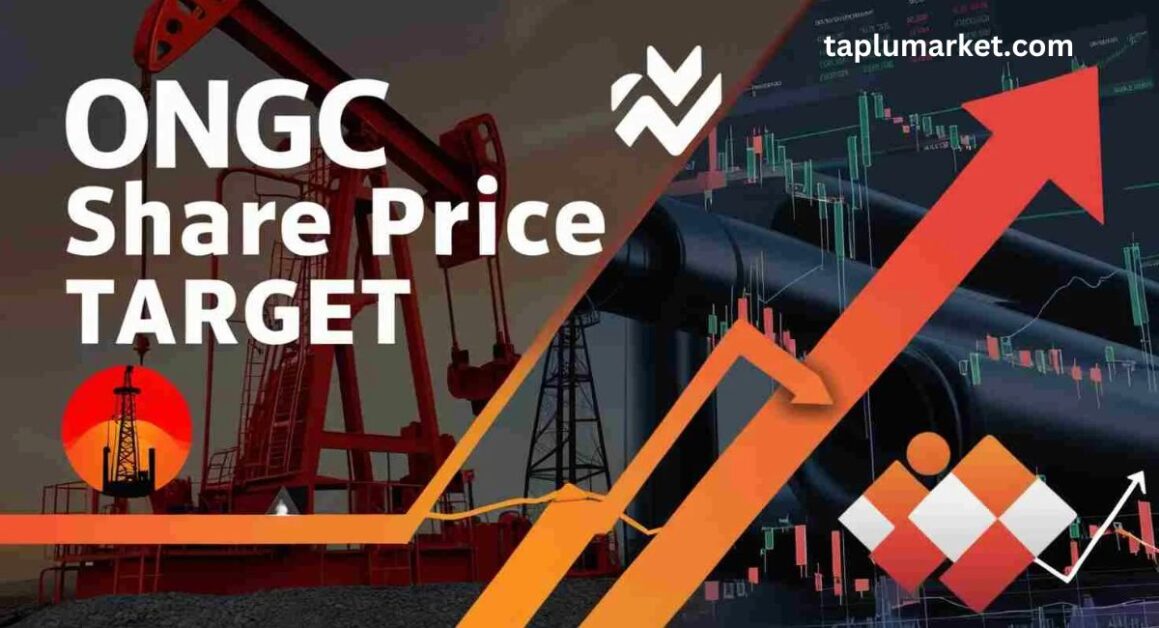Introduction
Oil and Natural Gas Corporation (ONGC) is India’s largest Maharatna public sector enterprise and a global leader in oil & gas exploration and production. With a dominant market share in India’s energy sector, ONGC plays a crucial role in meeting the country’s growing demand for crude oil and natural gas. As a dividend-paying stock backed by the Indian government, it has long been a favorite among investors seeking stability in the volatile energy market.
Investors are keenly watching ONGC Share Price Target 2025 to 2030 due to multiple factors—fluctuating crude oil prices, India’s push for energy self-reliance, ONGC’s expansion into renewables, and global geopolitical shifts affecting the oil & gas industry. With the world transitioning toward cleaner energy, ONGC’s ability to adapt while maintaining profitability will be a key determinant of its future share price growth.

This article provides a data-driven forecast for ONGC Share Price Target 2025 to 2030, analyzing key growth drivers, risks, and expert insights to help investors make informed decisions. Whether you’re a long-term investor or evaluating short-term opportunities, this guide will cover fundamental and technical analysis, government policies, and global market trends shaping ONGC’s future valuation.
Key Factors Influencing ONGC’s Share Price (2025-2030)
ONGC’s stock performance over the next decade will be shaped by a mix of global energy trends, domestic policies, and company-specific developments. Understanding these factors can help investors gauge whether ONGC will be a multibagger, stable dividend stock, or a risky bet in a transitioning energy market. Below are the most critical drivers that will impact ONGC Share Price Target 2025 to 2030:
1. Oil & Gas Demand-Supply Dynamics (Global & Domestic)
- India’s Growing Energy Demand: With rapid industrialization and urbanization, India’s oil & gas consumption is expected to rise, benefiting ONGC as the dominant domestic supplier.
- Global Supply Shocks: Geopolitical tensions (Middle East conflicts, Russia-Ukraine war) and OPEC+ production cuts can cause price volatility, directly affecting ONGC’s revenues.
- Shift to Gas Economy: Government push for natural gas as a transition fuel (City Gas Distribution networks, LNG infrastructure) could boost ONGC’s gas business.
2. Government Policies & Subsidies

- Fuel Subsidy Mechanism: Changes in LPG, kerosene, and diesel subsidies impact ONGC’s profit margins.
- Domestic Gas Pricing Reforms: Government-regulated gas prices in India influence ONGC’s realizations. A market-linked pricing system could improve profitability.
- Energy Security Focus: Policies like “Make in India” and reduced oil imports could favor ONGC’s exploration projects.
3. Exploration Success & Reserves Growth
- New Discoveries: ONGC’s ability to find new oil & gas reserves (e.g., Krishna-Godavari Basin, Arabian Sea blocks) will determine long-term sustainability.
- Enhanced Recovery Techniques: Adoption of advanced drilling & extraction methods can boost output from aging fields.
- Strategic Acquisitions: ONGC’s overseas ventures (e.g., Russia’s Vankor field, Mozambique LNG) could add to reserves but carry geopolitical risks.
4. Renewable Energy Shift & ONGC’s Adaptation
- Clean Energy Investments: ONGC is diversifying into solar, wind, and hydrogen to align with India’s 2070 net-zero target. Success here could attract ESG investors.
- Risk of Stranded Assets: If the global shift away from fossil fuels accelerates, ONGC’s traditional oil assets may lose value.
5. Global Crude Oil Price Trends
- Brent Crude Price Impact: ONGC’s profitability is directly tied to oil prices. 70−70−100/barrel is ideal for sustainable growth.
- Recession Risks: Economic slowdowns in the US/EU could reduce oil demand, pressuring prices.
- Dollar Strength: Since oil is traded in USD, a stronger dollar can impact ONGC’s realizations.
6. Competition from Private & International Players
- Reliance-BP, Vedanta, Adani: Private players are expanding in oil & gas, increasing competition.
- Global Majors (Exxon, Shell): Their tech advantage in deep-water exploration could challenge ONGC.
- ONGC’s Cost Efficiency: To remain competitive, ONGC must reduce production costs and improve operational efficiency.
ONGC Share Price Target 2025: Forecast & Analysis
Investors are closely watching ONGC’s share price target for 2025 as the company navigates evolving energy markets, government policies, and global oil price trends. Based on fundamental analysis, technical indicators, and market scenarios, here’s a detailed outlook for ONGC’s stock performance in 2025.

1. Bullish Scenario (High Oil Prices, Strong Demand) → Expected Price Range
Potential Price Range: ₹300 – ₹350 per share
Key Drivers:
- Sustained High Crude Oil Prices (90−90−100+ per barrel) boosting ONGC’s revenue.
- Strong Domestic Demand: India’s economic growth increases oil & gas consumption.
- Successful Exploration: Major discoveries or production boosts from new fields.
- Government Support: Favorable policies (e.g., gas pricing reforms, reduced subsidies).
Why This Matters:
- ONGC’s profits surge with higher oil realizations.
- Increased investor confidence could drive stock multiples higher.
2. Base Scenario (Moderate Growth, Stable Policies) → Expected Price Range
Potential Price Range: ₹220 – ₹280 per share
Key Assumptions:
- Oil Prices Stabilize (75−75−85 per barrel range).
- Steady Production Growth: No major disruptions in output.
- Balanced Energy Transition: Gradual shift to renewables without hurting core business.
Investor Takeaway:
- ONGC remains a stable dividend stock with moderate upside.
- Stock performance aligns with broader market trends.
3. Bearish Scenario (Economic Slowdown, Low Oil Prices) → Expected Price Range
Potential Price Range: ₹150 – ₹200 per share
Risk Factors:
- Global Recession reduces oil demand, pushing prices below $70.
- Subsidy Burden Increases due to political pressure.
- Exploration Setbacks: Dry wells or project delays.
- Renewables Disrupt Demand: Faster-than-expected shift away from fossil fuels.
Why Caution is Needed:
- ONGC’s earnings could decline, leading to lower valuations.
- Dividend cuts possible if profitability weakens.
4. Technical & Fundamental Analysis
Technical Indicators (Chart-Based Forecast)
- Support Levels: ₹180-200 (Strong historical base).
- Resistance Levels: ₹280-300 (Key breakout zone).
- Moving Averages: 200-DMA (long-term trend indicator).
Fundamental Metrics
- P/E Ratio: ~6-8x (Cheap vs. global peers).
- Dividend Yield: ~4-6% (Attractive for income investors).
- Debt-to-Equity: Low (Strong balance sheet).
ONGC Share Price Target 2026-2030: Medium to Long-Term Forecast
Investors evaluating ONGC’s stock potential between 2026 and 2030 must consider both growth opportunities and emerging risks in the evolving energy sector. Below is a detailed, data-backed outlook covering price projections, key drivers, and expert analysis.

4. ONGC Share Price Target 2026-2027 (Medium-Term Outlook)
Growth Drivers
| Factor | Impact on Share Price |
|---|---|
| New Offshore Projects (e.g., KG-D6, Mumbai High Redevelopment) | ↑ Increased production → Higher revenues |
| Government Backing (Strategic oil reserves, Atmanirbhar Bharat) | ↑ Policy stability → Investor confidence |
| Gas Price Reforms (Market-linked pricing) | ↑ Better profit margins |
| Overseas Acquisitions (Russia, Africa assets) | ↑ Reserves growth but carries geopolitical risk |
Potential Risks
| Risk | Impact on Share Price |
|---|---|
| Geopolitical Tensions (Middle East, Russia-Ukraine) | ↓ Oil supply disruptions → Price volatility |
| Energy Transition Speed (Faster EV/solar adoption) | ↓ Reduced fossil fuel demand |
| Subsidy Burden (LPG/kerosene subsidies) | ↓ Lower net realizations |
Analyst Predictions & Historical Trends
- 2026 Target: ₹250-320 (Moderate growth scenario)
- 2027 Target: ₹280-370 (If oil stays above $80)
- Dividend Expectation: 4-5% yield likely to continue
- Historical PE Range: 5-8x (Undervalued vs global peers)
ONGC Share Price Target 2028-2030 (Long-Term Outlook)
Key Deciding Factors
| Factor | Bullish Case (2030) | Bearish Case (2030) |
|---|---|---|
| Renewable Energy Shift | ONGC adapts well (Solar/Hydrogen investments pay off) | Struggles to pivot → Loses market share |
| Global Oil Demand | Slow decline (still >80M bpd) | Sharp drop (<70M bpd) → Price crash |
| Institutional Interest | ESG funds invest due to clean energy efforts | Dumped as “stranded asset” |
| Valuation (DCF Model) | ₹400-500 (if 3% annual growth) | ₹150-200 (if demand collapses) |
Long-Term Forecast Summary
✅ Optimistic Scenario (₹400+):
- Successful renewable diversification + high oil prices.
- Strong government support for energy security.
⚠️ Pessimistic Scenario (Below ₹200):
- Rapid energy transition → Oil becomes obsolete.
- Geopolitical crises disrupt operations.
Investment Recommendation (2026-2030)
- Short-Term (2026-27): Hold for dividends, trade on oil price swings.
- Long-Term (2028-30): Monitor ONGC’s renewable investments closely.
Should You Invest in ONGC for the Long Term? (2025-2030)

ONGC (Oil and Natural Gas Corporation) has long been a blue-chip stock for investors seeking stability in the energy sector. But with the global shift toward renewable energy and volatile oil prices, is ONGC still a smart long-term investment? Below, we break down the pros, cons, and expert recommendations to help you decide.
✅ Pros of Investing in ONGC (Reasons to Buy)
1. Stable Dividend Income
- ONGC has a consistent dividend payout history, often offering 4-6% dividend yield.
- Government ownership ensures reliable payouts, making it attractive for income investors.
2. Strong Government Backing
- As a Maharatna PSU, ONGC benefits from policy support (e.g., subsidies, exploration licenses).
- India’s push for energy self-reliance (Atmanirbhar Bharat) favors domestic producers.
3. Undervalued Compared to Global Peers
- Trading at P/E of 6-8x, much lower than global oil majors (ExxonMobil: ~10x, Shell: ~7x).
- Potential for re-rating if oil prices rise or reforms improve profitability.
4. Strategic Shift to Renewables & Gas
- Investing in solar, wind, and hydrogen to adapt to the energy transition.
- Expanding natural gas production (cleaner fossil fuel) aligns with global trends.
❌ Cons & Risks (Reasons to Be Cautious)
1. Volatile Oil Prices Impact Earnings
- ONGC’s profits directly depend on crude prices (70−70−100/barrel ideal).
- A global recession or demand slump could crash prices, hurting revenues.
2. Green Energy Shift Threatens Long-Term Demand
- EVs and renewables may reduce fossil fuel reliance by 2030.
- Risk of stranded assets if oil demand declines faster than expected.
3. Competition from Private Players
- Reliance, Adani, and Vedanta are expanding aggressively in oil & gas.
- ONGC must improve efficiency to compete with global giants like BP & Exxon.
4. Geopolitical & Subsidy Risks
- Government intervention in fuel pricing & subsidies can squeeze margins.
- Overseas assets (e.g., Russia) face sanction risks.
📈 Expert Recommendations (Buy/Hold/Sell?)
| Analyst View | Recommendation | Reasoning |
|---|---|---|
| Bullish | Buy | Undervalued, high dividends, oil rebound potential |
| Neutral | Hold | Good for dividends but limited upside due to energy transition risks |
| Bearish | Sell | Long-term oil demand uncertainty, better growth stocks available |
Final Verdict:
- Dividend Investors: Hold for steady income.
- Growth Investors: Look elsewhere unless ONGC accelerates its renewable energy shift.
- Short-Term Traders: Play oil price cycles (buy dips when crude is low).
Conclusion:
As we assess ONGC Share Price Target 2025 to 2030, the key takeaway is that this energy giant stands at a crossroads. On one hand, it offers stable dividends, government backing, and an undervalued stock—making it appealing for conservative investors. On the other, volatile oil prices, the global energy transition, and rising competition pose significant long-term risks.
Final Verdict on ONGC’s Growth Potential
- Short-Term (2025-2027): ONGC could see moderate upside if oil prices remain above $80, supported by India’s growing energy demand.
- Long-Term (2028-2030): The stock’s fate hinges on how well it adapts to renewables while maintaining profitability in oil & gas.
Disclaimer:
The advice or opinions given on Taplumarket are the personal views of the expert, the brokerage firm, the website or management is not responsible for it. Before investing, please consult your financial advisor or certified expert.






